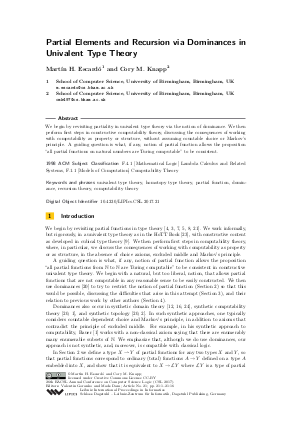Partial Elements and Recursion via Dominances in Univalent Type Theory
Authors Martín H. Escardó, Cory M. Knapp
-
Part of:
Volume:
26th EACSL Annual Conference on Computer Science Logic (CSL 2017)
Part of: Series: Leibniz International Proceedings in Informatics (LIPIcs)
Part of: Conference: Computer Science Logic (CSL) - License:
 Creative Commons Attribution 3.0 Unported license
Creative Commons Attribution 3.0 Unported license
- Publication Date: 2017-08-16
File

PDF
LIPIcs.CSL.2017.21.pdf
- Filesize: 443 kB
- 16 pages
Document Identifiers
Subject Classification
Keywords
- univalent type theory
- homotopy type theory
- partial function
- dominance
- recursion theory
- computability theory
Metrics
- Access Statistics
-
Total Accesses (updated on a weekly basis)
0Document
0Metadata
Abstract
We begin by revisiting partiality in univalent type theory via the notion of dominance. We then perform first steps in constructive computability theory, discussing the consequences of working with computability as property or structure, without assuming countable choice or Markov’s principle. A guiding question is what, if any, notion of partial function allows the proposition “all partial functions on natural numbers are Turing computable” to be consistent.
Cite As Get BibTex
Martín H. Escardó and Cory M. Knapp. Partial Elements and Recursion via Dominances in Univalent Type Theory. In 26th EACSL Annual Conference on Computer Science Logic (CSL 2017). Leibniz International Proceedings in Informatics (LIPIcs), Volume 82, pp. 21:1-21:16, Schloss Dagstuhl – Leibniz-Zentrum für Informatik (2017)
https://doi.org/10.4230/LIPIcs.CSL.2017.21
BibTex
@InProceedings{escardo_et_al:LIPIcs.CSL.2017.21,
author = {Escard\'{o}, Mart{\'\i}n H. and Knapp, Cory M.},
title = {{Partial Elements and Recursion via Dominances in Univalent Type Theory}},
booktitle = {26th EACSL Annual Conference on Computer Science Logic (CSL 2017)},
pages = {21:1--21:16},
series = {Leibniz International Proceedings in Informatics (LIPIcs)},
ISBN = {978-3-95977-045-3},
ISSN = {1868-8969},
year = {2017},
volume = {82},
editor = {Goranko, Valentin and Dam, Mads},
publisher = {Schloss Dagstuhl -- Leibniz-Zentrum f{\"u}r Informatik},
address = {Dagstuhl, Germany},
URL = {https://drops.dagstuhl.de/entities/document/10.4230/LIPIcs.CSL.2017.21},
URN = {urn:nbn:de:0030-drops-76822},
doi = {10.4230/LIPIcs.CSL.2017.21},
annote = {Keywords: univalent type theory, homotopy type theory, partial function, dominance, recursion theory, computability theory}
}
Author Details
References
-
Andrej Bauer. First steps in synthetic computability theory. Electronic Notes in Theoretical Computer Science, 155:5-31, 2006.

- Andrej Bauer and Davorin Lešnik. Metric spaces in synthetic topology. Annals of Pure and Applied Logic, 163(2):87-100, 2012. Third Workshop on Formal Topology. URL: http://dx.doi.org/10.1016/j.apal.2011.06.017.
-
Ana Bove. General Recursion in Type Theory, pages 39-58. Springer, 2003.

-
Ana Bove and Venanzio Capretta. Nested General Recursion and Partiality in Type Theory, pages 121-125. Springer, 2001.

-
Ana Bove and Venanzio Capretta. A Type of Partial Recursive Functions, pages 102-117. Springer, Berlin, Heidelberg, 2008.

-
Douglas Bridges and Fred Richman. Varieties of constructive mathematics, volume 97 of London Mathematical Society Lecture Note Series. Cambridge University Press, 1987.

-
Venancio Capretta. General recursion via coinductive types. Logical Methods in Computer Science, 15:1-28, 2005.

-
James Chapman, Tarmo Uustalu, and Niccolò Veltri. Quotienting the Delay Monad by Weak Bisimilarity, pages 110-125. Springer, Cham, 2015.

- Cyril Cohen, Thierry Coquand, Simon Huber, and Anders Mörtberg. Cubical type theory: a constructive interpretation of the univalence axiom. arXiv, November 2016. URL: https://arxiv.org/abs/1611.02108.
- Thierry Coquand, Bassel Mannaa, and Fabian Ruch. Stack semantics of type theory. arXiv, 2017. URL: https://arxiv.org/abs/1701.02571.
-
J. Martin E. Hyland. The effective topos. Studies in Logic and the Foundations of Mathematics, 110:165-216, 1982.

-
J. M. E. Hyland. First steps in synthetic domain theory, pages 131-156. Springer, 1991.

-
S. Kleene. Introduction to Metamathematics, 1952.

-
N. Kraus, M. H. Escardó, T. Coquand, and T. Altenkirch. Notions of anonymous existence in Martin-Löf type theory. Logical Methods in Computer Science, 2017.

-
Piergiorgio Odifreddi. Classical Recursion Theory. Elsevier, 1989.

- B. Reus and Th. Streicher. General synthetic domain theory - A logical approach (extended abstract), pages 293-313. Springer Berlin Heidelberg, Berlin, Heidelberg, 1997. URL: http://dx.doi.org/10.1007/BFb0026995.
- Egbert Rijke. Homotopy type theory. Master’s thesis, Utrecht University, 2012. URL: https://hottheory.files.wordpress.com/2012/08/hott2.pdf.
- Egbert Rijke. The join contruction. arXiv:1701.07538, Jan 2017. URL: https://arxiv.org/abs/1701.07538.
-
H. Rogers, Jr. Theory of Recursive Functions and Effective Computability. MIT Press, 1987.

- G. Rosolini. Continuity and Effectiveness in Topoi. PhD thesis, University of Oxford, 1986. URL: ftp://ftp.disi.unige.it/person/RosoliniG/papers/coneit.ps.gz.
-
Nils Anders Danielsson Thorsten Altenkirch and Nicolai Kraus. Partiality, revisited: The partiality monad as a quotient inductive-inductive type. In FoSSaCS Proceedings, 2017.

-
A. S. Troelstra. A note on non-extensional operations in connection with continuity and recursiveness. Indag. Math., 39(5):455-462, 1977.

- The Univalent Foundations Program. Homotopy Type Theory: Univalent Foundations of Mathematics. https://homotopytypetheory.org/book, Institute for Advanced Study, 2013.
- Jaap van Oosten and Alex K. Simpson. Axioms and (counter)examples in synthetic domain theory. Annals of Pure and Applied Logic, 104(1):233-278, 2000. URL: http://dx.doi.org/10.1016/S0168-0072(00)00014-2.
- V. Voevodsky. Resizing rules. Invited talk at Types'2011, Bergen, September 2011. URL: http://www.math.ias.edu/vladimir/files/2011_Bergen.pdf.
